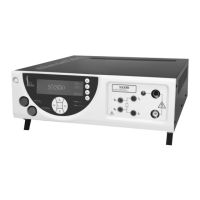XS series operating manual
XS user manual v0.55 - 136 -
Dielectric strength tests
The dielectric strength test is intended to stress components and sub-assemblies of electrical
equipments and to check that the leakage lines either between points or between points and ground are
correctly designed according to the used technology.
The principle of a dielectric strength test is to apply a voltage (DC or AC) between defined points and
after voltage stabilization, to check that the leakage current, created by breakdown phenomena or
breakdown discharges (in the air or in the insulating materials), is not greater than the nominal
acceptable value.
The default sanction is determined by the analyze of the shape, the amplitude and the holding time of
the current supplied by the generator to the specimen under test and by comparison with a preset limit.
Selection of the test voltage
The dielectric strength tests intending to verify that materials or equipments comply with standard
requirements, it is important to refer to these standards to select the voltage.
In case of no indication regarding the test voltage, a common rule is to apply the following formula :
Utest = 2 x Unominal + 1000 volts
Most of the standards specify the type of the test voltage : AC (50-60Hz) or DC. A common rule is to test
the specimen with a test voltage of the same type that the voltage which will be apply during the final
use. However, certain among of technical difficulties exist which force to depart from this common rule.
Dielectric strength tests with an ac voltage
BENEFITS :
The specimen is stressed with the both voltage polarities.
The specimen being not charged, there is no need for a discharge system
DISADVANTAGES :
Most of the tested specimens having a certain amount of capacitance, the HV source have to supply
the leakage current as well as the reactive current, this involves an over-sized generator with an
increase in prices, in weight and a decreasing of the operator safety who is exposed to higher
currents.
The reactive current can be evaluated with the following formula :
Impedance = Voltage / Current (Ohm’s law : Z=U/I)
for capacitances : Z = 1 / Cw with w = 2*Pi*F
reactive current : Ir = U*C*2*Pi*F
i.e. U=3000 volts C=1nF (~ 10 meters of shielded cable)
Ir=3000*1E-9*2*3.14*50=0.942 mA
Require to adjust the permanent leakage current threshold (IMAX) regarding the capacitance of each
specimen.
When testing a specimen which will be used with a DC voltage, the AC voltage test can result in a
decreasing of the life time because in particular of the heating and the CORONA effect. Under the
effect of an electrical field, the orientation of molecules is done with friction which will occur with an
AC voltage at each cycle (every 20 or 16 mS). Consequently the AC test is more severe than the DC
voltage test.

